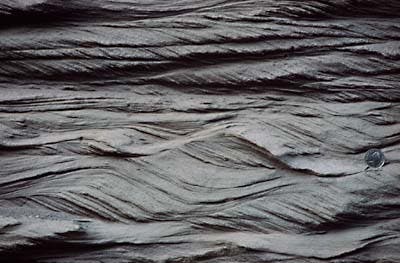NASA recently uploaded a strikingly beautiful photograph on their website showing a petrified sand dune on Mars. The image was actually pieced together from several shots taken using Curiosity’s Mast Camera (Mastcam) on August 27th. From end to end, the panorama spans a full 135 degrees of other-worldly awesomeness, with east to the left and southwest to the right.

Image via NASA
The component images in the center and upper portion of the mosaic are from Mastcam’s right-eye camera, which is equipped with a 100-millimeter-focal-length telephoto lens. Images used in the foreground and at far left and right were taken with Mastcam’s left-eye camera, using a wider-angle, 34-millimeter lens.
The structures are part of the Stimson unit on Mount Sharp (or Aeolis Mons, clocking in at 5.5 km height from the valley floor of Gale crater). They don’t look quite like this on Mars – the pictures were white balanced and color corrected to correspond to daytime lighting conditions here on Earth.
Grab your hardhat and pencil, it’s fieldwork time
My educational background is geophysics. I investigate geological structures and physical anomalies tied to geological settings using physical methods – such as ground-penetrating radar, measurements of the Earth’s magnetic field, resistivity and conductivity readings, and a lot of other cool, geeky stuff that girls hanging out in bars really like hearing about.
But as everyone who studies earth sciences, I was also thought about geology and geological processes, and i have a pretty good grasp of the important phenomena that make our planet look, feel, and behave the way it does. So without further ado, let’s take a look at the outcrop.
The sandstone slabs can be easily discerned, and they show a characteristic named cross bedding, very similar to what a geologist would find on Earth. For non-geologists out there, cross bedding means, simply put, that the rocks look “flow-y,” like this:

Image via indiana.edu
To understand bedding, you must first get a general idea of how sedimentary geological structures form – sedimentation.
Let’s take a particle, such as a speck of dust, a grain of sand, or even piece of a larger, already formed rock. It can, over time, get dislodged or eroded from their resting place, and become incredibly mobile. This is the first step in how these rocks form – formation of sediment.
Several forces, such as gravity, running water and even wind can then carry and deposit them far away from an initial spot to a sedimentary area, such as the face of the dune that is not swept by wind – this is the second step, transport.
Over time, if enough particles are carried, they solidify under immense pressure and sometimes temperature to form sedimentary rocks – in geology we call this third step lithification.
Now, let’s take our initial spot on the top of a mountain, and our sedimentary area in a wide delta with a river flowing down connecting the two. In the steep mountainous terrain, the river flows fast and erodes pieces of the mountain, taking material – from decently sized rocks and small pebbles all the way to particles as fine as a human hair – on the journey to the delta.
Downriver, as the terrain gets flatter, the waterway widens and becomes lazy, flowing slowly and peacefully to the delta. As the water looses speed, it also looses the energy it needs to carry larger pieces of material, so they drop to the bottom – here sedimentary rocks will be coarser. The lighter particles can still be carried and sediment further away, and here the rocks will be much finer.

Image via geology
In this case, where the sedimentary zone is nice and horizontal and the water flows slowly, there is nothing to disturb the sediment so all packets of rocks will be relatively flat, and of similar thickness.
But if we spice things up a bit, and have our initial spot on the left (and wind-swept) side of a dune, particles will be carried over the top and put to rest on the other sloped side – we will see cross-bedding. This is the phenomena that likely created this dune and the cross bedded sandstone we see in the NASA picture.

If the rocks form in an watery environment, either very close to the surface waves or where water flows in such a way as to disturb the sediment, then too we will see cross bedding. In a way, what you would see in a cross laminated or cross strata packet of rocks in this case is fossilized movement of the medium that transports the material.
Where does it go from here?
On Earth, the cycle of erosion and sedimentation is never truly over. What is now a delta could, with a little tectonic help, become a mountain and feed another sedimentary area on its own.
The packets of rocks could get melted and their minerals would form fresh volcanic rocks, or squished and pulled and turned and heated into metamorphics. These can then become eroded, and the cycle continues. Slowly, too slow for a human to perceive, the rocks move, get transformed, destroyed and formed anew.
Scientific consensus is that Mars is no longer tectonically active. It’s waters are frozen or lost in space, and its atmosphere is barely even there – it’s almost 100 times thinner than on Earth. Sediments will have a hard time being transported by anything other than gravity, so what Mars should experience is just a leveling out, as the terrain seeks to flatten out under the strain of its own weight. But that would happen very, very, very slowly.
Chances are, if you ever reach Mars, those dunes will still be there.


